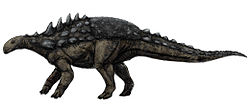Newly named archosauromorphs
Newly named basal archosauromorphs
| Name | Status | Authors | Age | Unit | Location | Notes | |
|---|---|---|---|---|---|---|---|
Newly named dinosaurs
| Name | Novelty | Status | Authors | Age | Unit | Location | Notes | Images |
|---|---|---|---|---|---|---|---|---|
| Astrodon johnstoni | Gen. et sp. nov. | Valid | Leidy | Early Cretaceous (Aptian/Albian boundary) | Arundel Formation | An indeterminate titanosauriform. |  | |
Preoccupied. | Late Cretaceous (early Maastrichtian) | An ornithomimid. Preoccupied by Owen 1854. | ||||||
Preoccupied | Hitchcock | Preoccupied by Fitzinger, 1843. Later renamed Amphisaurus . | ||||||
Valid | Sir Richard Owen vide Anonymous. | Early Cretaceous (Barremian) |  | |||||
Preoccupied. | Maastrichtian | Navesink Formation | Preoccupied by Duméril 1853 Later renamed Diplotomodon . | |||||
